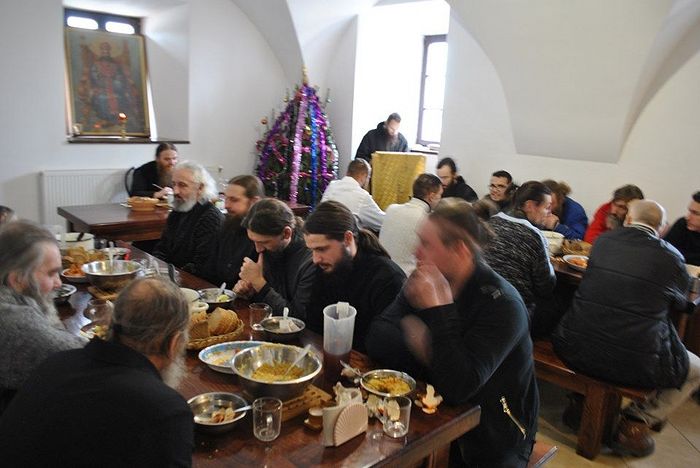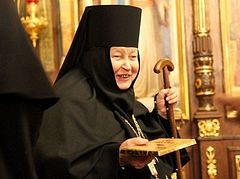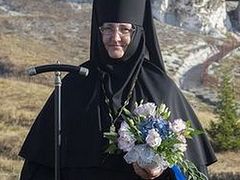Our visit to the Monastery of St. John the Merciful, Patriarch of Alexandria, in the village of Zagaitsy of the Diocese of Ternopil and Kremenets in Western Ukraine, took place after our acquaintance with the abbot of this ancient monastery (which is currently being revived), Archimandrite German (Velkov). We first met him at the convent of Kremenets, where he had arrived to congratulate the oldest abbess of the Ukrainian Orthodox Church, Mother Marionilla (Panasyuk), who was then celebrating her eighty-seventh birthday and the seventieth anniversary of her monastic life.
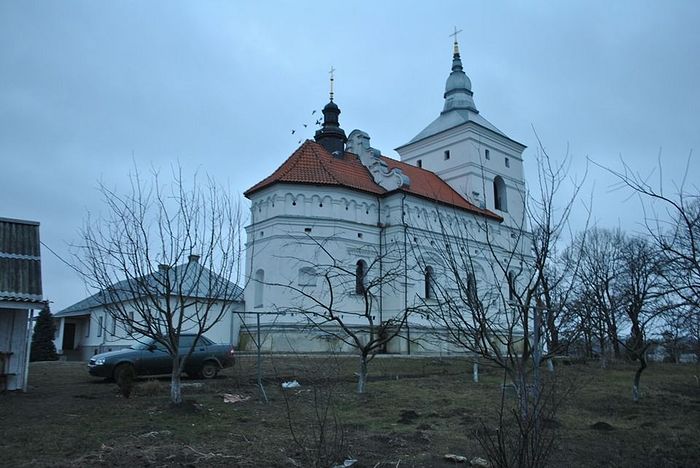 The Monastery of St. John the Merciful in Zagaitsy
The Monastery of St. John the Merciful in Zagaitsy
Archbishop Job’s story
We also asked for the blessing for this trip from the Bishop of Shumsk, the Vicar-Bishop of Ternopil and the rector of the Pochaev Theological Seminary Archbishop Job (Smakouz). He was born in that region, has an excellent knowledge of the history of Shumsk, and he was visiting Kremenets on that day as well.
“You definitely should visit this monastery!” His Eminence replied. “My reposed father, Archpriest Fyodor Smakouz (†2019), served in Zagaitsy and neighboring villages. He told me about the prophecy of a monk of this monastery who was a ‘fool-for-Christ’—in the form of oral tradition it was passed on from generation to generation by local pious residents. It happened during the ‘Polish’ period of the monastery’s history, between 1920 and 1939. One day, during the stay of Dionizy (Waledynski; 1876–1960), the abbot of the Holy Dormition Pochaev Lavra and the Metropolitan of Warsaw, in this monastery, he was informed that there was a blessed clairvoyant Russian monk named Fr. Spyridon there. These were unsettling times, when Roman Catholics were striving to destroy Orthodoxy in Poland through the Polish courts and take all the churches and monasteries from the Orthodox.
“The metropolitan wished to see Fr. Spyridon and talk to him. When the blessed elder was led up to the hierarch, Dionizy asked him: ‘Father, what do you think is in store for the monastery of Zagaitsy?’ The elder answered the metropolitan calmly with an affected feeble-mindedness: ‘Nettles will grow on the site of our newly-built and solemnly blessed water-pumping station and pigs will live in the beautiful abbot’s quarters where we are talking now.’ Indignant at the clairvoyant monk’s odd words, the metropolitan’s entourage were about to throw him out, but the hierarch stopped them and wondered, ‘And what will be next, after this abomination of desolation?’ And the man of God replied: ‘The monastery of Zagaitsy will become as beautiful as Pochaev Lavra, and Pochaev Lavra will be like Holy Jerusalem!’
“The first and sad part of the elder’s prophecy was fulfilled with literal exactness a few decades later. By order of the new ‘chiefs’ there was the village dump, overgrown with nettles and other weeds, on the site of the water-pumping station; and the ransacked and half-ruined abbot’s lodging was used as a pigpen by the last clergyman from the former monastery brethren to make ends meet and pay taxes to the Soviet authorities.
“The fulfilment of the second part of the prophecy of the monastery’s revival depends on our faith, prayers and spiritual labors. All the external conditions for this have already been given by God to our people. The monastery is being revived and prospers. Go and see this with your own eyes!”
Meeting the monastery
And we set off. A turning from the Kremenets-Shumsk asphalt road to the dirty rain-swept road made the old monastery car cut its speed, which only slightly exceeded the speed of the rare teams of rural horses we encountered on the way. Having gone another dozen miles over the rough road, we saw the monastery’s white walls on a hill, along with the spire of the bell-tower, a church-fortress with embrasures under its roof, the monastic building, and a neat huge stack of split wood in the shape of a round tower in the yard that gradually loomed up in the distance.
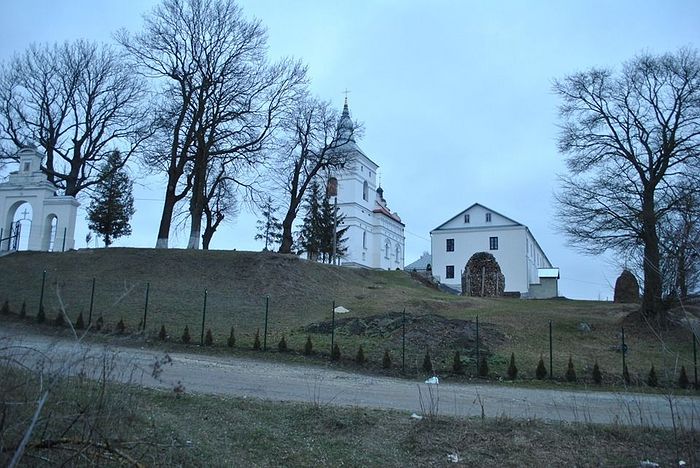 The twilight sky over the monastery
The twilight sky over the monastery
Night was falling. The cold wind with sleet, which melted as soon as it reached earth, were making the bottom of the cassock of the monastery deputy abbot, Hieromonk Ambrose (Sadovy), flap about. He came out to meet us with the greeting:
“Welcome! You’ve arrived just on time for the evening meal!”
In the refectory shchi (cabbage soup) and pea porridge were steaming on the table; there was also delicious brown bread, compote and fruits. Having given us his blessing, the abbot kindly allowed us to take some pictures and invited us to the table. After the joint prayer a monk started reading the Life of the saint of the day, and only the clattering of spoons on the plates of the brethren who were eating, along with sound of the wind outside the window, echoed the monk’s story.
The same atmosphere could have been felt in the monastery 400 years ago when it was founded; the same original monastic rules and prayers are strictly kept and continued here to this day. What changes are the forms of trials out of envy of the enemy of mankind to monastic life, which, according to St. Ignatius (Brianchaninov), is “not only in the attainment of salvation, but, for the most part, in achieving Christian perfection.”
A journey into history
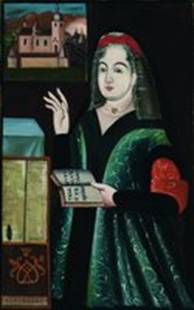 Irina Yarmolinskaya. A copy of the portrait. The late twentieth to early twenty-first centuries. The monastery of Zagaitsy. “Why is the monastery named in honor of St. John the Merciful?” we asked Fr. Ambrose after the meal.
Irina Yarmolinskaya. A copy of the portrait. The late twentieth to early twenty-first centuries. The monastery of Zagaitsy. “Why is the monastery named in honor of St. John the Merciful?” we asked Fr. Ambrose after the meal.
“It’s very likely that the foundress of this monastery, Irina Yarmolinskaya, a colonel’s widow, a wealthy local landowner—venerated St. John the Merciful, Patriarch of Alexandria, who lived in the seventh century, very much. The life of this holy hierarch was filled with extraordinary works of mercy; he would call the poor and destitute ‘my lords, who will contribute to the salvation of my soul and lead me into the eternal abodes,’” Fr. Ambrose explained, inviting us to a tour around the monastery.
“Irina Yarmolinskaya, the lady of these lands, was extremely merciful too: she would aid the poor and indigent, and after the deaths of her husband and daughter she made a pilgrimage to the Kiev Caves Lavra where she met its abbot, Archimandrite Peter (Mohyla), the future holy Metropolitan of Kiev. Metropolitan Peter devoted his entire life to reviving Orthodoxy in right-bank Ukraine which at that time was under the control of Rzeczpospolita [the Polish-Lithuanian Commonwealth.—Trans.],” Fr. Ambrose proceeded, showing us a copy of the portrait of the monastery’s foundress. “The original seventeenth-century’s portrait is kept at the local history museum of Kremenets. Thus, with the blessing of St. Peter (Mohyla) and through the prayers of St. Job of Pochaev this monastery in Zagaitsy was established in 1625.
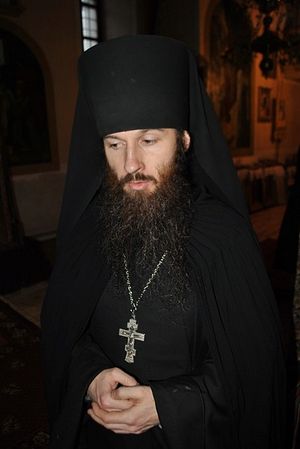 Our guide, Hieromonk Ambrose (Sadovy) “Irina Yarmolinskaya also gave extensive lands to the monastery and secured her will with an ‘Endowment Charter’ of August 28, 1637, in which she bade the monks ‘to remain in Orthodoxy, the Greek faith, and not in the Unia, without fail.’ The same Charter also read: ‘By the Grace of God I exercise my will to endow this renewed monastery for evermore.’
Our guide, Hieromonk Ambrose (Sadovy) “Irina Yarmolinskaya also gave extensive lands to the monastery and secured her will with an ‘Endowment Charter’ of August 28, 1637, in which she bade the monks ‘to remain in Orthodoxy, the Greek faith, and not in the Unia, without fail.’ The same Charter also read: ‘By the Grace of God I exercise my will to endow this renewed monastery for evermore.’
“The landowner endowed the monastery she funded with ‘endowments for evermore’: a fish pond in the hamlet of Stupno, a mill, arable fields, hayfields, groves and oak forests in hamlet Khmelishche, and gardens. The monastery was given the village which later came to be known as Malye Zagaitsy. According to her will, she was buried there, next to the graves of her husband and their daughter who died young. By the way, a copy of that Endowment Charter is still kept in the sacristy of Pochaev Lavra, which is some thirty miles away from Zagaitsy. This Charter bears the signature of St. Job of Pochaev (†1651) himself: ‘Ioann Zhelezo, Abbot of Pochaev, as requested, sealed this with his own hand.’”
In the Church of St. John the Merciful
Fr. Ambrose led us through the floors (which smelled of fresh paint) of the monastic building that adjoined the main Church of St. John the Merciful. He told us that the monastic building had been half-ruined and later it was restored and finished through the brethren’s efforts. After the closure of the monastery in 1950 the monastic building housed a village school, a village hall, a sewing workshop, and a civil aviation tracker station.
Via the monastic building’s side passage we reached the heart of the monastery: the Church of St. John the Merciful.
The freshly-laid parquet floors exhaled the pleasant scent of the wood of coniferous trees. The sanctuary was adorned with an ancient iconostasis with ancient icons.
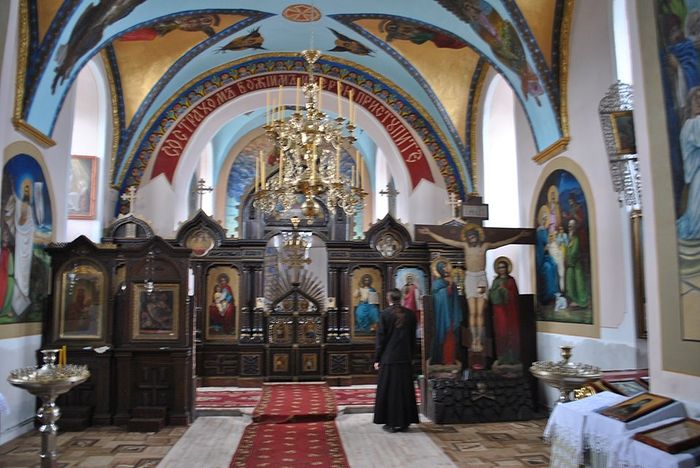 In the Church of St. John the Merciful
In the Church of St. John the Merciful
We learned from our guide that it was designed as a fortified church: a big bell-tower with embrasures for cannon and mortars towers above the entrance and occupies half of the roof of the small church. The embrasures (twenty-four in number) are situated around the whole church building perimeter. Such strategy of the church design was explained by frequent raids of enemies—from Tartars hordes to Latin invaders.
 The “All-Merciful” wonderworking icon of the Theotokos of Zagaitsy There is the monastery’s main relic to the left of the iconostasis: the wonderworking “All-Merciful” icon of the Mother of God of Zagaitsy.
The “All-Merciful” wonderworking icon of the Theotokos of Zagaitsy There is the monastery’s main relic to the left of the iconostasis: the wonderworking “All-Merciful” icon of the Mother of God of Zagaitsy.
“The eighteenth century was the most difficult period in the history of the monastery (in addition to the second half of the twentieth century),” Fr. Ambrose went on with his story. “At the beginning of that century the descendants of Irina Yarmolinskaya and her Orthodox son Jan (Ioan) Yarmolinsky renounced their Orthodox faith. From 1709 on they repeatedly attempted to force the monastery to accept the Unia, and in 1721 under the influence of the Polish authorities it became Uniate. In 1749, Stefan Yarmolinsky, volodar (mayor) of Shumsk, donated this icon of the Mother of God and the Infant Christ to the monastery. According to tradition, the icon had been found in the forest not far from Zagaitsy in the time of St. Job of Pochaev. It can be said that the Queen of Heaven Herself decided to keep this monastery. In 1794, it returned to the Orthodox Church. Between 1818 and 1853 a religious school for children of the clergy of the Kremenets uezd (district) that was later transferred to Kremenets was attached to the monastery. The monastery was noted for its library with books and documents dating from the sixteenth to eighteenth centuries, including a copy of the famous Ostrog Bible [one of the earliest East Slavic translations of the Bible and the first complete printed edition of the Scriptures in Church Slavonic, published in Ostrog in what is now Ukraine in 1581 by the printer Ivan Fyodorov.—Trans.].
“The early twentieth century saw the period of the monastery’s prosperity when in 1912 it was raised to the first rank.
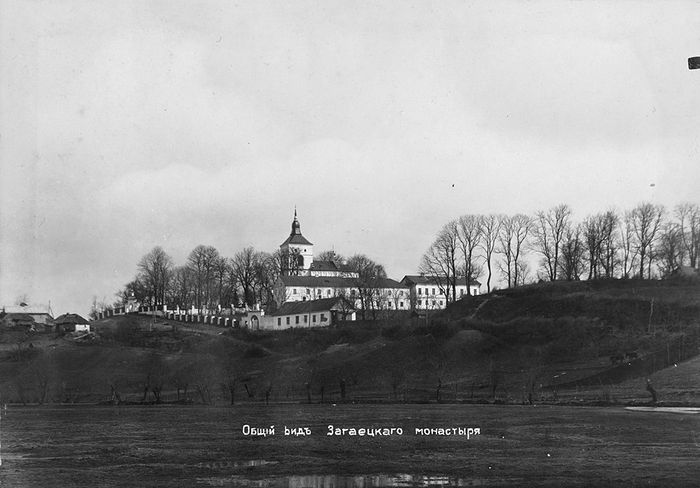 The monastery of Zagaitsy, the early twentieth century. In 1917 it also possessed a large monastery pond, an apiary, a field, along with a number of barns and working buildings in hamlet Dvorishche
The monastery of Zagaitsy, the early twentieth century. In 1917 it also possessed a large monastery pond, an apiary, a field, along with a number of barns and working buildings in hamlet Dvorishche
“In the 1920s and 1930s the monastery’s community consisted of two schema-hieromonks (Elders Vitaly and Parthenius), fifteen ordained monks, nine monks, and thirty novices. With the new authorities and the Second World War, monastic life at the monastery considerably weakened, so after the end of the war only twenty-two monks remained there.
“An interesting historical fact: In 1922, a number of renowned religious and public figures were tonsured as monks at the Monastery of St. John the Merciful in Zagaitsy. Metropolitan Alexei (Gromadsky), who was murdered on the way to Ternopil on May 7, 1943, lived there at one time and then became its frequent guest. Now his relics rest at the Theophany Convent in Kremenets, waiting for the day of their glorification. Between 1929 and 1933, the abbot of this monastery was Archimandrite Panteleimon (Rudyk; †02.10.1968), who later served as the father-superior of Pochaev Lavra and the first bishop of the Russian Orthodox Church in Canada (the Archbishop of Edmonton).
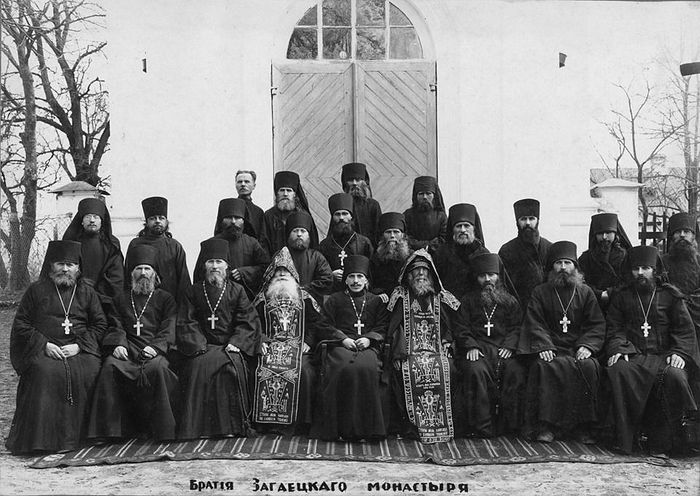 The monastery brethren in the 1930s.
The monastery brethren in the 1930s.
“With the coming of the Soviet atheist authorities to Volhynia in 1939, the monastery lay under a threatening cloud. In 1950, the monastery was closed, its living quarters and working buildings were given to a local collective farm named after Kalinin [Mikhail Kalinin was the USSR Head of State between 1919 and 1946.—Trans.]. The authorities more than once attempted to close the Church of St. John the Merciful, but Zagaitsy residents stood up for it and it was used as a parish church permanently till 2007, when by the decision of the UOC-MP’s Holy Synod monastic life was resumed at this monastery.
The martyrs of 1943
“But the wartime year 1943 deserves special attention in the monastery’s history. Then the following monks of the monastery’s skete were martyred by the Nazis: Hieromonks Nilus (Gritsyuk), Millisen, Innocent, Sabbatius, and Geronty; Hierodeacon Sophrony; Monks Dositheus, Vincent, Benjamin, Cornelius and Nikolai (the surnames are not identified). They were executed by shooting by a German SS punishment unit on Lazarus Saturday, April 19, 1943.
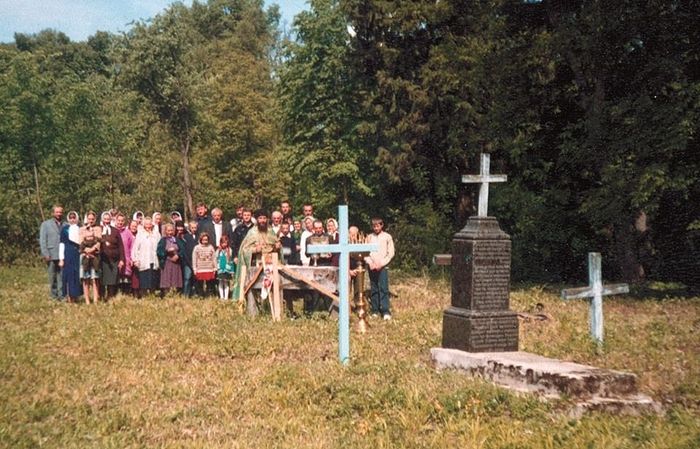 A memorial service on the site of the former monastery skete with the participation of Zagaitsy residents
A memorial service on the site of the former monastery skete with the participation of Zagaitsy residents
“According to the evidence of one of the hieromonks who survived, the future Archimandrite Methodius (Sibikovsky; †1964), it was a pre-planned operation in revenge for the activities of guerilla groups by Semyon Kovpak and for hiding OUN (the Organization of Ukrainian Nationalists) soldiers. The skete was burned down, and almost the whole community was executed by shooting. Monk Pachomius alone was sent to Shumsk with a team of horses and a note to the German headquarters which said that the horses should be turned over to headquarters and the monk should be shot. Fortunately Fr. Pachomius knew German: after reading the accompanying letter he turned off the road and escaped.
“Not long ago the martyred brethren’s remains were transferred from the original burial site (on the territory of the former skete) to the crypt of the monastery church, situated in its vault.”
Together with Hieromonk Ambrose (Sadovy), the monastery deputy abbot, we “crawled” down into the church crypt through a narrow passage.
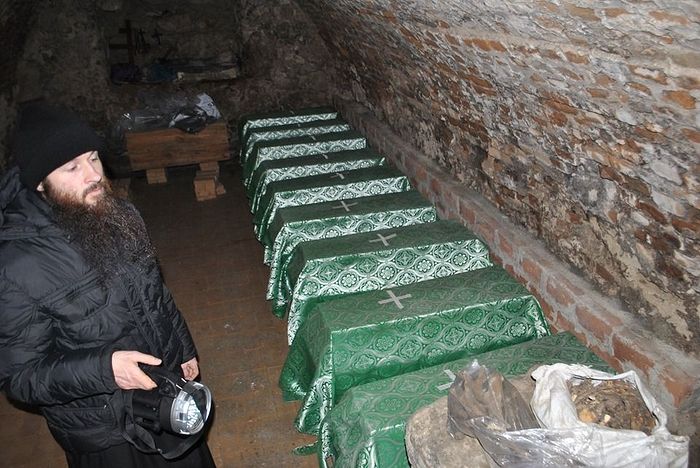 The relics of the martyred skete brethren (†19.04.1943)
The relics of the martyred skete brethren (†19.04.1943)
“It took us many days to clear the burial vault,” Fr. Ambrose related. “We removed tons of trash (that we carefully sorted out) from here in the car. We discovered the remains of some unknown burials in it. Having repaired the crypt, we moved the martyred brethren’s relics here.”
Leaving the monastery
Before our departure we expressed our sincere gratitude to Fr. German, the monastery father-superior, for the hearty welcome they gave us and asked him the final question:
“Father, what have the brethren done over the twelve years since the monastery’s revival?”
“Our small community has exerted tremendous efforts. The future monks first came here when the monastery was in ruins, desolation and neglect. It is known to the Lord alone whether they have done much or little. Since 2007 the monastic building has been restored and finished; in fact it has been rebuilt from bottom to top. The church has been renovated; the boiler house for heating has been built and equipped; along with the refectory, the kitchen, the cells; the monastery gate has been restored; paths have been laid; a young orchard has been planted. The brethren work day and night. In addition, some village residents and parishioners of the monastery help us: they are not indifferent to its future and are always ready to share with everyone that the monastery has been and will remain the heart and the soul of their native village. However, we desperately need more funds to continue our work at the monastery. We hope that the Lord, the Theotokos, and St. John the Merciful will help us…”
Fr. German said at parting:
“Do come again in summer, when our orchards give their fruit, our bees produce honey, and white mushrooms await you in the woods and oak groves .The doors of the Monastery of St. John the Merciful are open to everybody!”
And he gave us his blessing before the journey back.

